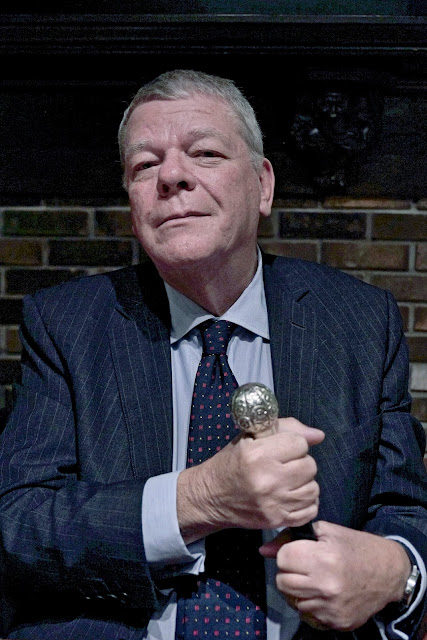L'Orfeo & Two 6ft 2in Theorbos
Sunday, November 05, 2017
 |
| Stephen Stubbs, Maxine Eilander, Tess Altiveros & Colin Baltzer |
In 1965 I was a shaved-head conscript in the Argentine Navy. I had a lovely girlfriend of Austrian extraction who one day told me, “You are an uncouth and uncultured man. I am going to take you to see a couple of operas at the Teatro Colón.”
I put on my heavy wool Botany Bay American suit (it was
one of those sweltering December Buenos Aires summers) and my first opera was
Prokofiev’s The Fiery Angel. The second one (still in that suit) was Christoph
Willibald Gluck’s — Orfeo ed Euridice.
Because it was 1965 only a scholar would have known of
the existence of Claudio Monteverdi’s early 1607 opera (better called Favola in
Musica) L’Orfeo.
But I find it amazing that in this day and age where
music genres are shifting to each other that nobody would have mentioned that
other Orfeo. That other Orfeo contained some of the most achingly beautiful
music of the 20th century.
The work in question is French director Marcel Camus’s
1959 film Orfeu Negro (Black Orpheus). Its music features three Brazilian
composer/performes who since then have become legends. They are Luiz Bonfá, Antônio Carlos Jobim and João
Gilberto. Perhaps to North American people there is perhaps no knowledge that
one of the writers was the poet Vinicius de Moraes.
Of him Wikipedia states:
Lyricist, essayist,
and playwright who later became a seminal figure in modern Brazilian music and
literature. He served as a diplomat; composed his own bossa nova music; and as
an interpreter of his own lyrics, recorded several albums.
Because I am Latin American and because I happen to like jazz, the release in 1962 of Stan Getz and Charlie Byrd’s Jazz Samba marked a moment in my life that I have never forgotten. The movement called Bossa Nova might have been ushered in by Orfeu Negro.
Because I am Latin American and because I happen to like jazz, the release in 1962 of Stan Getz and Charlie Byrd’s Jazz Samba marked a moment in my life that I have never forgotten. The movement called Bossa Nova might have been ushered in by Orfeu Negro.
Of the Monteverdi L’Orfeo I grilled Ian Fenlon, Professor
Emeritus of Historical Musicology, Cambridge University about the work at his
very good talk on October 31 at the Green College.
 |
| Iain Fenlon |
He told me that there was no evidence that Gluck might
have known about the Monteverdi Orfeo as 150 years had passed. I noted that the
librettist of the 1607 work Alessandro Striggio wrote a poem, Rinaldo that
years later became that famous Handel opera. Fenlon nodded negatively so I will
have to keep my theory in check.
Coincidentally and it is only coincidence (Fenlon hinted
at) many of Monteverdi’s beginnings and endings in L’Orfeo feature chaconnes
(my absolute faves) and Gluck’s work has a dance section called Chaconne.
Getting back to the sumptuous performance at the Chan on
October 29 there were some instances that are now etched in my memory. One of
them was Orfeo’s (Colin Baltzer, tenor) Possente Spirto in the third act.
Baltzer told me that it is unique in opera. But I also noticed how it all began
with 2 violins, Tekla Cunningham and Ingrid Matthews and then the addition of
two theorboss (the 6ft 2inch long ones) John Lenti ad Stephen Stubbs, and the
organ, Henry Lebedinsky. Then it was the entrance of two cornettos (cornetti?)
Kiri Tollaksen and Alexandra Opsahl. One of the cornettists played backstage
for that striking echo effect. If that was not enough the two violins and the
cello, David Morris, played with Maxine Eilander’s harp and she even had a solo
part!
What was the second instance eteched in my memory? It is not ofted that I have the pleasure of being able to listen to two Theorbos (John Lenti and Stephen Stubbs). It was the former who confirmed my suspicion that Stubbs at 6ft 1 inch is just one inch shorter than his theorbo.
What was the second instance eteched in my memory? It is not ofted that I have the pleasure of being able to listen to two Theorbos (John Lenti and Stephen Stubbs). It was the former who confirmed my suspicion that Stubbs at 6ft 1 inch is just one inch shorter than his theorbo.
All I can add is that musical director the Pacific
MusicWorks Orhcestra, Stephen Stubbs has just the right touch to make this work
seem like they were playing for the duke in a small salon. The duke, of course
was yours truly!
I might add that I was witness to the 2000 Orfeo in
Vancouver in which Colin Baltzer was one of the shepherds. I was pleasantly
delighted to find out that Euridice played by Tess Altiveros (with ringlets her
dark hair would have made her look like a most Grecian Penelope) was my
cababayan. Both are mothers are Filipino.
Matthew Treviño, the baritone who sang Caronte looked the
part with his gray/black hair. The handsome man’s father is from Monterrey. In
Mexico we calle them regiomontanos.
And I could not possible finish this without mentioning
that the Dark Horse Ensemble won my heart.







